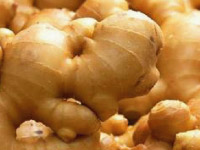
Ginger is the rhizome of the plant Zingiber officinale and is said to be native to tropical Asia, from India, Thailand, Laos, and Myanmar through to Malaysia. Ginger has long been used in Chinese herbal medicine for its medicinal properties. The raw tubers (ginger root) is effective for a healthy stomach, to remove toxins, reduce fever, clear the nose, suppress coughing, stop nausea and so on. Dried ginger (dried after steaming) stimulates the body's metabolism, has good warming properties and helps to relieve colds, stomach aches and diarrhea as well as being effective against feeling the cold and bedwetting.
The heat in ginger comes from zingerone crystals and the oily shogaol and zingiberene, both of which are essential oils. These constituents help to keep the stomach healthy by promoting the secretion of stomach juices, promoting digestion and appetite. It is also used for sweating and fevers, to stop coughs, reduce immflammation and swelling, and for warming the body. In particular, Zingerone has powerful antibacterial properties against the typhoid and cholera bacteria. It also effectively kills the Anisakis larvae.
It is said to have arrived in Japan from China (the old country of Wu 222 - 280). And is mentioned in such old tomes as the Record of Japan in the History of Wei and the Kojiki, where it is called 'hajikami'.
Ginger is classed as large, medium or small, and within each of the three groups there are different cultivars, but property-wise there is very little difference.
The Large Ginger Group was introduced at the beginning of the Meiji era as Canton ginger and is grown in Kyushu, Shikoku and warm parts of Kansai and Kanto. These late harvested cultivars are tall, growing to 70 - 10℃m, the bases of leaf stems are pale and there are not many offshoots. The stalks above ground number around 20, and from 800g to 1kg of rhizomes can be harvested from a single plant, which is a good yield. The flesh is soft in texture and this ginger is a bit mild, but it gets hotter as it matures, however it does not store well. The ginger cultivated within Kagoshima Prefecture is large ginger.
The Medium Ginger Group is used for with its leaves still attached and as blanched ginger. It developed around the Kansai area and has spread throughout the rest of the country. It is middle to late harvested cultivar, has fat rhizomes and grows robustly. Rhizome yield is 600g. It grows to about 50cm in height and has numerous offshoots, sending out about 50 shoots.
The Small Ginger Group is largely used for blanching and is produced mainly in the Kanto area. It is ready for harvesting early to mid-season, with thin stems, numbering about 40. Rhizomes are thin and fibrous. They are not very juicy and are very hot. Yield is about 500g.
Where temperature conditions for growing are concerned, ginger is grown from the hot, wet tropics to temperate areas. In mainland Kagoshima Prefecture, it dies off during the winter cold. Rhizomes do not become dormant and when the temperature rises above 18 ℃, they begin to sprout and send out shoots.
Temperatures between 25 and 30 ℃ are best for growing and growth will stop if the temperature falls below around 15 ℃. Ginger will rot at temperatures of 10 ℃ or less.
Where soil conditions are concerned, sandy and clay soils are all right, but deep, well-draining, moisture-retentive soils are best. The roots require a growing bed of at least 2℃m so the ground must be tilled deeply.
Where water is concerned, ginger dislikes arid conditions, and likes humidity, so if there is insufficient moisture in the soil it will stop fattening. For this reason, irrigation is very effective on ginger crops.
Where exposure to sunlight is concerned, during the initial stages of growth, it likes the shade. During the peak growth stage it requires a lot of sunshine. Repetitive use of the same fields can cause diseases from continuous cropping and yield will fall.
I.O.D. Farms are producing organically grown local ginger on farmland that matches these conditions in Thailand and Laos. Enough spare fields remain uncultivated, so if you would like to use the farmland, we will supply it. We will also sell and export the ginger grown on these farms. If you would like a sample, we will send it to you with actual expenses including the postage on a parcel.
Sub-contracting by I.O.D. and out-sourced production are also possible. Just give us a call.



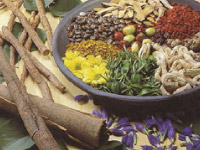 Around the world, with a sudden demand for Chinese herbal medicine, which is gentle on the body, it is becoming increasingly difficult to obtain supplies of the raw materials. Demand in China itself, the great producer of Chinese medicinal herbs, is expanding rapidly and there are reports that this traditional exporter will be banning exports of the raw materials, and manufacturers of Chinese herbal medicines in all countries could possibly be directly hit by difficulty in securing supplies of raw materials. For this reason, we are looking for places to grow them in an effort to evade such risk.
Around the world, with a sudden demand for Chinese herbal medicine, which is gentle on the body, it is becoming increasingly difficult to obtain supplies of the raw materials. Demand in China itself, the great producer of Chinese medicinal herbs, is expanding rapidly and there are reports that this traditional exporter will be banning exports of the raw materials, and manufacturers of Chinese herbal medicines in all countries could possibly be directly hit by difficulty in securing supplies of raw materials. For this reason, we are looking for places to grow them in an effort to evade such risk. 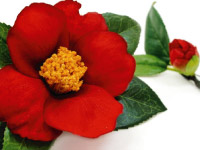 Camellia oil is obtained from camellia seeds. Camellias belong to the Thaeacae family and can be found over a wide area, from Eurasia to the African continent, and from the Australian continent to the South American continent. In recent years, with the rising interest in natural things, the excellent properties and characteristics of natural camellia oil have been attracting renewed attention. Usage is being extended to a variety of fields such as a base for soaps and skin care products and as an ingredient in food, and it is increasingly being spotlighted.
Camellia oil is obtained from camellia seeds. Camellias belong to the Thaeacae family and can be found over a wide area, from Eurasia to the African continent, and from the Australian continent to the South American continent. In recent years, with the rising interest in natural things, the excellent properties and characteristics of natural camellia oil have been attracting renewed attention. Usage is being extended to a variety of fields such as a base for soaps and skin care products and as an ingredient in food, and it is increasingly being spotlighted. Pepper is a spice, medicinal product and food that has been produced in South East Asia for a long time, and it is said to have originated in the Indochina Peninsula. During the time of the British Empire and colonization of India and Indo China by Britain, European merchants took the pepper food culture to Europe and incorporated pepper into European food culture as a valuable spice. And it was for this wonderful spice that European countries pushed so forcefully into South East Asia with their powerful colonization strategies.
Pepper is a spice, medicinal product and food that has been produced in South East Asia for a long time, and it is said to have originated in the Indochina Peninsula. During the time of the British Empire and colonization of India and Indo China by Britain, European merchants took the pepper food culture to Europe and incorporated pepper into European food culture as a valuable spice. And it was for this wonderful spice that European countries pushed so forcefully into South East Asia with their powerful colonization strategies. Wasabi is a type of perennial brassica and is a condiment used in Japanese cuisine for the fiery way it stimulates the nose. Historically it is recorded as having been used since the Heian Period and it is thought that wasabi has long been a popular ingredient. From the Edo Period, people started eating sashimi and grated wasabi dampens the raw fishy smell, enhances the flavor of the fish, and helps to prevent food poisoning, so it has long been loved and used by ordinary people.
Wasabi is a type of perennial brassica and is a condiment used in Japanese cuisine for the fiery way it stimulates the nose. Historically it is recorded as having been used since the Heian Period and it is thought that wasabi has long been a popular ingredient. From the Edo Period, people started eating sashimi and grated wasabi dampens the raw fishy smell, enhances the flavor of the fish, and helps to prevent food poisoning, so it has long been loved and used by ordinary people.  The king of all fragrances in the world Agarwood oil is obtained from Aquilaria trees. This tree can only be grown in Thailand, Laos and Cambodia and is very valuable tree. The raw oil is used to perfume a variety of cosmetic products (perfumes, shampoo, soap, aroma oils, body oils, medicine and incense). It has been used around the world from ancient times in many ways, including directly as fragrant wood.
The king of all fragrances in the world Agarwood oil is obtained from Aquilaria trees. This tree can only be grown in Thailand, Laos and Cambodia and is very valuable tree. The raw oil is used to perfume a variety of cosmetic products (perfumes, shampoo, soap, aroma oils, body oils, medicine and incense). It has been used around the world from ancient times in many ways, including directly as fragrant wood. 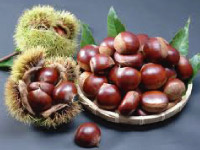 Chestnuts grow in temperate regions and are widespread throughout Asia. From 3 to 4 years is required for trees to grow big enough for the nuts to be harvested. Chestnut trees are not so difficult to grow. However, if the temperature drops too low, they will suffer from frost damage and die in about 2 years. So that is the main thing to be careful of. Apart from that is the fact that delicious fruit attracts bugs. The main pests that attack chestnuts are the chestnut weevil (Curculio sikkimensis) and the nut fruit moth (Cydia kurokoi). The way to eradicate these pests is to fumigate the chestnuts with methyl fume. We also recommend that they be kept in cold storage.
Chestnuts grow in temperate regions and are widespread throughout Asia. From 3 to 4 years is required for trees to grow big enough for the nuts to be harvested. Chestnut trees are not so difficult to grow. However, if the temperature drops too low, they will suffer from frost damage and die in about 2 years. So that is the main thing to be careful of. Apart from that is the fact that delicious fruit attracts bugs. The main pests that attack chestnuts are the chestnut weevil (Curculio sikkimensis) and the nut fruit moth (Cydia kurokoi). The way to eradicate these pests is to fumigate the chestnuts with methyl fume. We also recommend that they be kept in cold storage. 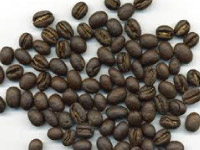 We contract out the cultivation on the Bolaven Plateau. This plateau has a cool climate with a minimum temperature of 10℃ and a maximum of 30 ℃, and vegetables can be grown year round. Arabica coffee here is grown organically, the coffee is smooth with a quality fragrance. The Vietnamese coffee well known in Japan is in many cases made from beans that originated from this Bolaven Plateau. I have heard that it is being sold to Starbucks for use in its menu.
We contract out the cultivation on the Bolaven Plateau. This plateau has a cool climate with a minimum temperature of 10℃ and a maximum of 30 ℃, and vegetables can be grown year round. Arabica coffee here is grown organically, the coffee is smooth with a quality fragrance. The Vietnamese coffee well known in Japan is in many cases made from beans that originated from this Bolaven Plateau. I have heard that it is being sold to Starbucks for use in its menu.  Looking at production trends of natural rubber worldwide, the total yield from plantations in Thailand, Indonesia and Malaysia accounts for 70% of the whole.
Looking at production trends of natural rubber worldwide, the total yield from plantations in Thailand, Indonesia and Malaysia accounts for 70% of the whole. 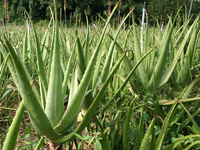 Endemic to areas from Northern Africa to the Arabian Peninsula, some people say that the original species came from the Mediterranean Sea area. The name Aloe comes from the Arabic word 'alloeh', which means bitter. When leaves of the aloe Vera are cut, they exude a sticky juice.
Endemic to areas from Northern Africa to the Arabian Peninsula, some people say that the original species came from the Mediterranean Sea area. The name Aloe comes from the Arabic word 'alloeh', which means bitter. When leaves of the aloe Vera are cut, they exude a sticky juice. 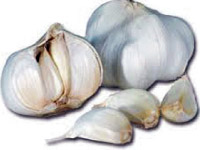 How about growing garlic in Thailand, Myanmar or Laos, the home of garlic production?
How about growing garlic in Thailand, Myanmar or Laos, the home of garlic production?  Ginger is the rhizome of the plant Zingiber officinale and is said to be native to tropical Asia, from India, Thailand, Laos, and Myanmar through to Malaysia. Ginger has long been used in Chinese herbal medicine for its medicinal properties. The raw tubers (ginger root) is effective for a healthy stomach, to remove toxins, reduce fever, clear the nose, suppress coughing, stop nausea and so on. Dried ginger (dried after steaming) stimulates the body's metabolism, has good warming properties and helps to relieve colds, stomach aches and diarrhea as well as being effective against feeling the cold and bedwetting.
Ginger is the rhizome of the plant Zingiber officinale and is said to be native to tropical Asia, from India, Thailand, Laos, and Myanmar through to Malaysia. Ginger has long been used in Chinese herbal medicine for its medicinal properties. The raw tubers (ginger root) is effective for a healthy stomach, to remove toxins, reduce fever, clear the nose, suppress coughing, stop nausea and so on. Dried ginger (dried after steaming) stimulates the body's metabolism, has good warming properties and helps to relieve colds, stomach aches and diarrhea as well as being effective against feeling the cold and bedwetting.  Konjac yams are grown on the Bolaven Plateau at a height of about 1100 meters above sea level, and located in the northwest part of Champasak Province in Southern Laos.
Konjac yams are grown on the Bolaven Plateau at a height of about 1100 meters above sea level, and located in the northwest part of Champasak Province in Southern Laos. 





















